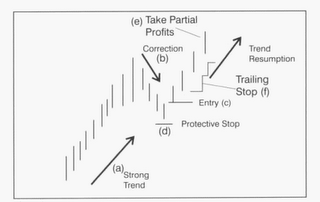Okay, I wanted to follow up on Trader:R's comments yet again about playing the pullback vs. playing the breakout.
What is the PullBack pattern?
There are variations of this (I think Dave Landry devoted a few chapters of his book to this pattern that he pioneered), but essentially, a pullback is a stock that is temporarily moving in the opposite direction of its prevailing trend. A pullback that breaks an established support/resistance level could develop into a break of the prevailing trend. However, if the support/resistance level holds up, or the pullback reverses, then that presents a very high probability, low risk entry. That is the essence of the pullback pattern - finding the low risk entry point into an already trending stock. An example best illustrates this: And a more realistic (and recent) example:
And a more realistic (and recent) example:
Characteristics of the pullback pattern:
1. There is declining volume during the pullback, meaning that the wave of selling is weaker than the previous wave of buying.
2. Various candlestick patterns indicate signs of a possible reversal from the pullback.
3. Pre-existing prevailing trend
The time to enter a position is as soon as the stock tells you that it is reversing from the pullback.
One variation of this pullback pattern is the first pullback after a high volume breakout or break to new highs/lows. In this case, the reversal of this first pullback is even lower risk than the normal pullback pattern because the reversal of this first pullback is the first confirmation of the trend. After this, many more institutions/traders are typically drawn towards this stock.
What makes this pullback pattern work so well is that you are buying when the herd is selling (just before they realize that they should be buying instead of selling!)
As I've mentioned before in my followup about the breakout pattern, playing the breakout or playing the pullback are both equally valid strategies. So when should you play the breakout, and when is playing the pullback better? I don't know the answer to that, and this is where it becomes more art than science.
DailyReview (123)
futures (108)
futuresTrading_Plan (73)
MarketReview (66)
trades (56)
uranium (47)
swing (46)
victories (42)
Ideas (40)
bigger Picture (40)
screwUps (35)
OffTopic (34)
options (34)
chartReview (30)
LearningCurve (22)
Pattern Catalog (14)
sectors (13)
rules (9)
TechTrends (8)
Euro (7)
daytrades (7)
trendDays (7)
MonthlyReview (6)
ProductReview (5)
Trading System (4)
Followers
Sunday, October 08, 2006
The PullBack pattern
Posted by
Phileo
at
12:11 AM PermaLink This!
![]()
![]()
Labels: Pattern Catalog
Subscribe to:
Post Comments (Atom)
 BlogLine This!
BlogLine This!

No comments:
Post a Comment